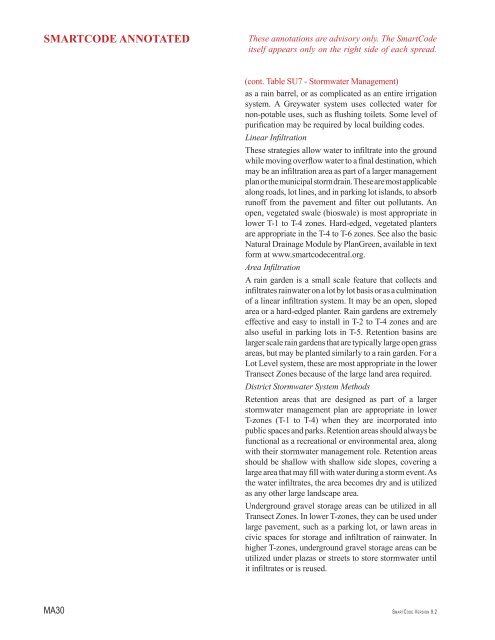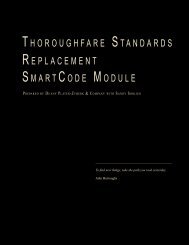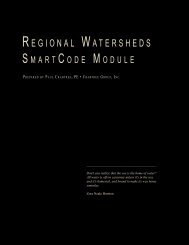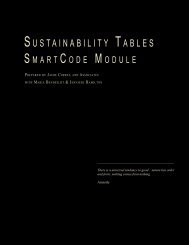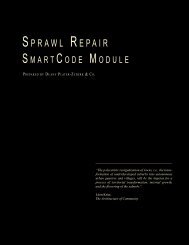U BANISM - Center for Applied Transect Studies
U BANISM - Center for Applied Transect Studies
U BANISM - Center for Applied Transect Studies
Create successful ePaper yourself
Turn your PDF publications into a flip-book with our unique Google optimized e-Paper software.
SMARTCODE ANNOTATED<br />
These annotations are advisory only. The SmartCode<br />
itself appears only on the right side of each spread.<br />
(cont. Table SU7 - Stormwater Management)<br />
as a rain barrel, or as complicated as an entire irrigation<br />
system. A Greywater system uses collected water <strong>for</strong><br />
non-potable uses, such as flushing toilets. Some level of<br />
purification may be required by local building codes.<br />
Linear Infiltration<br />
These strategies allow water to infiltrate into the ground<br />
while moving overflow water to a final destination, which<br />
may be an infiltration area as part of a larger management<br />
plan or the municipal storm drain. These are most applicable<br />
along roads, lot lines, and in parking lot islands, to absorb<br />
runoff from the pavement and filter out pollutants. An<br />
open, vegetated swale (bioswale) is most appropriate in<br />
lower T-1 to T-4 zones. Hard-edged, vegetated planters<br />
are appropriate in the T-4 to T-6 zones. See also the basic<br />
Natural Drainage Module by PlanGreen, available in text<br />
<strong>for</strong>m at www.smartcodecentral.org.<br />
Area Infiltration<br />
A rain garden is a small scale feature that collects and<br />
infiltrates rainwater on a lot by lot basis or as a culmination<br />
of a linear infiltration system. It may be an open, sloped<br />
area or a hard-edged planter. Rain gardens are extremely<br />
effective and easy to install in T-2 to T-4 zones and are<br />
also useful in parking lots in T-5. Retention basins are<br />
larger scale rain gardens that are typically large open grass<br />
areas, but may be planted similarly to a rain garden. For a<br />
Lot Level system, these are most appropriate in the lower<br />
<strong>Transect</strong> Zones because of the large land area required.<br />
District Stormwater System Methods<br />
Retention areas that are designed as part of a larger<br />
stormwater management plan are appropriate in lower<br />
T-zones (T-1 to T-4) when they are incorporated into<br />
public spaces and parks. Retention areas should always be<br />
functional as a recreational or environmental area, along<br />
with their stormwater management role. Retention areas<br />
should be shallow with shallow side slopes, covering a<br />
large area that may fill with water during a storm event. As<br />
the water infiltrates, the area becomes dry and is utilized<br />
as any other large landscape area.<br />
Underground gravel storage areas can be utilized in all<br />
<strong>Transect</strong> Zones. In lower T-zones, they can be used under<br />
large pavement, such as a parking lot, or lawn areas in<br />
civic spaces <strong>for</strong> storage and infiltration of rainwater. In<br />
higher T-zones, underground gravel storage areas can be<br />
utilized under plazas or streets to store stormwater until<br />
it infiltrates or is reused.<br />
MA30 S m a r t C o d e Ve r s i o n 9.2


